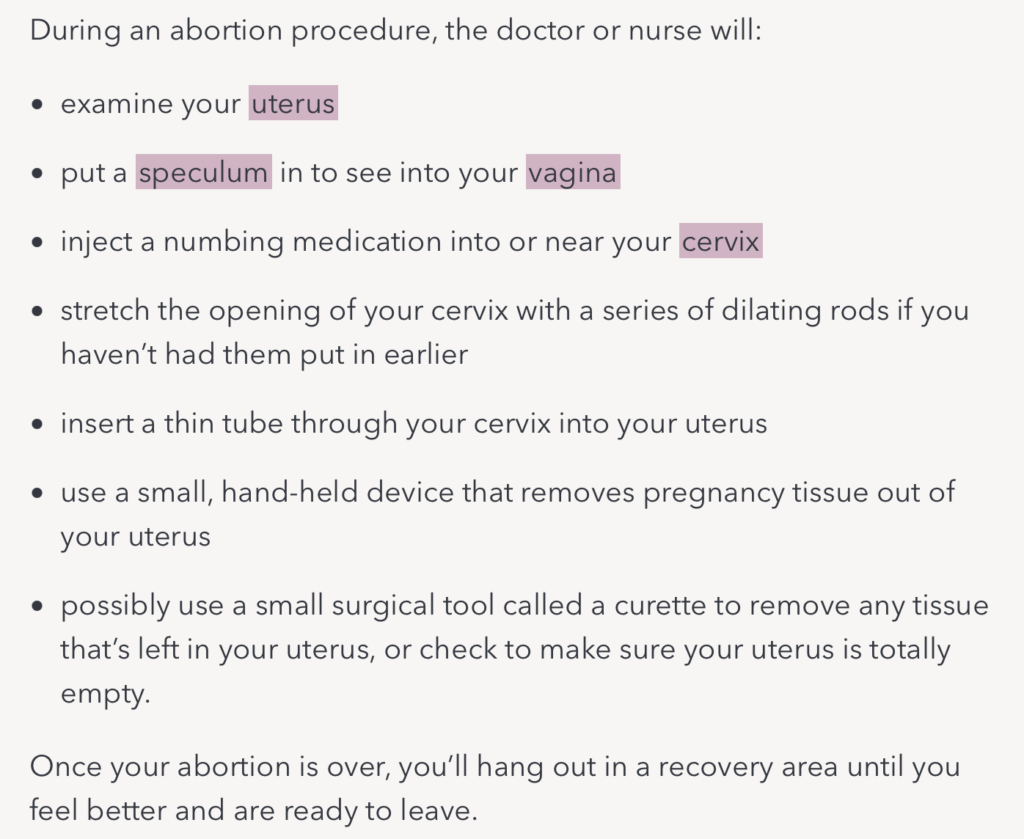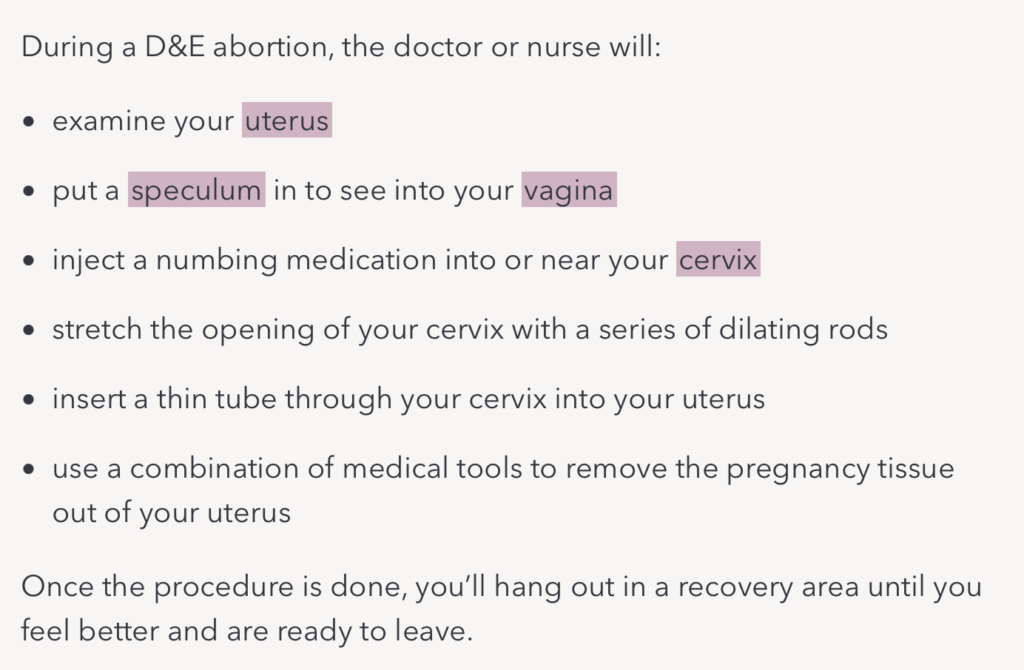October 31, 2022
by Alexis Goodman
Part 2 of 3
Now that we have covered the why’s of abortion, it becomes necessary to investigate the how’s. How is abortion performed? Who performs them? Are they dangerous?
As reported by the World Health Organization, somewhere around 73 million induced abortions happen every year around the world. It is highly likely more occur than that, since the countries where abortion is illegal or restricted have many unreported abortions.
An abortion is put into two categories, medical or surgical, and performed in one of six ways: medication, dilation and curettage (D&C), manual vacuum aspiration, dilation and evacuation (D&E), intracardiac injection abortion, and dilation and extraction (D&X). Each of these are performed at different times and the availability of them depend on where you reside.
First Trimester Abortions
The first trimester are weeks 0-13, and when all the baby’s internal organs are developed. By week five, the heart will begin to beat. By week six, the nose, mouth, ears, intestines, and brain start to develop. By week seven, hands and feet are making an appearance and the baby’s nociceptors (pain receptors) are forming. By week eight, more nerve cells are being created and so are the lungs. By week ten, tiny nails are taking shape on the baby’s fingers. By week eleven, the baby is almost fully formed and can even hiccup. By week twelve they are making sucking movements with their mouth and their fingers and toes are curling and uncurling. Finally, by week thirteen, they have their own fingerprints.
Abortion Pill: This is the only medical procedure, as it is done through taking two different types of medication. It is an option up to week eleven of pregnancy. The first pill is called mifepristone, and they will probably give a woman this during her first visit to the clinic. This pill thins the lining of your uterus, making it uninhabitable for the embryo to implant, thereby causing the death of the embryo. The effects of the pill cannot be reversed after being ingested. After taking it, bleeding will start within 30 minutes to 3-4 hours. Heavy bleeding will occur and last for up 4-8 hours after it starts. The second pill is called misoprostol and it can either be taken immediately after or 48 hours after. Either way, it rejects the embryo from the woman’s body. A third visit will be required to ensure the baby has been expelled.
Other examples of abortion pills are the morning after pill or Plan B.
D&C Abortion: This is considered a surgical abortion, as are the rest of the methods mentioned hereafter. Available between week 5-13, this procedure is the most common of all. The woman will be brought into a room that looks like an exam room. She will then be asked to lay down on the bed and put her feet in stirrups or a footrest of some kind. The baby is larger at this point, so a speculum will be used to open the vagina and dilators will be used to enlarge the cervix. Commonly used are metal rods, and because this can be painful, anesthesia may be used. This is necessary so the abortionist can have access to the baby. A suction catheter is then inserted and through the force of ten to twenty times that of a house vacuum, the baby will be sucked out piece by piece. Because leaving pieces in the woman’s uterus leaves her susceptible to infection, a curette is used to scrape out whatever of the baby remains. This generally takes 5-10 minutes. This is how Planned Parenthood described the process:

Manual Vacuum Aspiration: This procedure can also be done during the first trimester, and it is generally done in poorer countries. The procedure is the same as a D&C, except instead what is used is the suction from a syringe to pull apart the baby. Due to the weak suction, the baby is ripped apart much slower. Keep in mind, a baby develops his or her pain receptors by week seven.
Second Trimester Abortions
During the second trimester, which is weeks 14-27, the baby grows from the size of a lemon to a cauliflower. By week fourteen, the baby now has brain impulses, and they can make facial expressions, and they can be seen on an ultrasound sucking their thumb. By week seventeen, their skeleton is hardening to bone. By week eighteen, they commonly flex their arms and legs. By week nineteen, the baby can smell, have vision, touch, taste, and hear (especially their mother’s voice). By week twenty-two, they will look like a newborn, just tiny.
D&E Abortion: The procedure is done between weeks 13 and 24. This is how Planned Parenthood explains the D&E procedure:

Their ambiguity is imperative for customer service, as it obscures the more unpleasant details of this type of abortion. About 24 to 48 hours prior to the procedure, an abortionist will use laminaria (sterilized seaweed that absorbs water and expands) to dilate the woman’s cervix. When she comes in for the procedure, she will require further dilating with metal rods and a speculum. A suction catheter will be slid in to drain the amniotic fluid. A sopher clamp, an instrument with rows of sharp teeth, will then be used to pull at the baby’s arms and legs which will essentially end with their limbs being torn from their body.
After the skull, usually in pieces, is removed, a curette is then used to scrape out the uterus. An abortionist that performed over 1,200 abortions, Dr. Anthony Levatino, stated, “A head in a baby that size is about the size of a large plum. You can’t see it…. You know you did it right if you crush down on the instrument [the Sopher clamp] and white material runs out of the cervix. That was the baby’s brains. Then you can pull out skull pieces.”
When the abortionist has finished the procedure, he then attempts to reassemble the baby’s body on a tray to ensure nothing was left in the mother. The whole process takes two to three days and the actual removal of the baby takes only 10-20 minutes.
Third Trimester Abortions:
This is the final trimester of a pregnancy, weeks 28-38. By week thirty-one, the baby can turn his or her head from side to side. By week thirty-three, their skull is still not fused yet and is soft.
Intracardiac Injection Abortion: This is an abortion that can be done from week twenty-five to full term. Because the baby is so large, an abortion such as this must take up to three to four days. A syringe will be injected through the mother’s abdomen into the baby, introducing a medicine used for heart failure, but with such large doses, it can cause cardiac arrest. It is called digoxin and kills the baby. Laminaria will be inserted into the cervix, and by day two the process will be repeated as needed. Eventually, the woman will go into labor and deliver a dead baby.
D&X Abortion: After week eighteen, this procedure can be utilized and is sometimes labeled a “partial-birth abortion”. After two days of attempting to dilate the mother’s cervix, the woman will come back in to have the final step performed. The abortionist will use an ultrasound to locate the legs or lower extremities of the baby. He will then use large grasping forceps to seize one of the legs and pull it into the vagina. Then, using his fingers, the abortionist will deliver most of the baby, but leaving the head in the uterus. Using blunt curved Metzenbaum scissors, the doctor will force them in at the base of the skull, spread them, and create an opening. A suction catheter will be inserted in the hole and the baby’s brains will be sucked out, thereby collapsing the skull, and thereby making it easy to extract the entire baby.
A nurse who assisted once on a dilation and extraction abortion said, “The doctor kept the baby’s head just inside the uterus. The baby’s little fingers were clasping and unclasping, and his feet were kicking. Then the doctor stuck the scissors through the back of his head, and the baby’s arms jerked out in a flinch, a startle reaction, like a baby does when he thinks that he might fall.”
Prior to the Partial-Birth Abortion Ban Act of 2003, it has been reported 80% of the babies aborted this way were normal, and the majority were viable. Now in the United States, D&X abortions are banned except for in life-threatening cases of the mother. In Canada, where there are no restrictions on abortion, there is no limit to when this technique can be used, although they generally resort to D&E’s for the majority of their abortions.
It has became the mantra of those who are pro-choice to state that women who seek abortions after 20 weeks only do so because of life-threatening situations. In a journal published by Guttmacher Institute, an associate of Planned Parenthood, shows that is no longer true. They now generally do so for the reasons of most elective abortions: financial issues, partner issues, etc.
The Impact of Abortion
The World Health Organization reported that in the world, 45% of all abortions are unsafe. For every 100,000 unsafe abortions, thirty women die in developed regions and developing regions see 220 deaths annually. It has been scientifically proven that life begins at conception. So therefore, for every safe abortion, there is one life that is guaranteed to be lost. For every unsafe abortion, there is guaranteed to be one life lost. That means 73 million plus lives are lost every year to abortion.
If you are curious about what any of these instruments spoken of look like as well as abortion instruments used in the past, click here.
____________________________________________________________________________________

Alexis Goodman was raised on a ranch in Dadeville, Missouri. She loves spending time with her husband, reading, hiking mountains, and learning new hobbies. She is currently a student at Brigham Young University-Idaho, where she is working to get a degree in Political Science with an emphasis on American Government.

